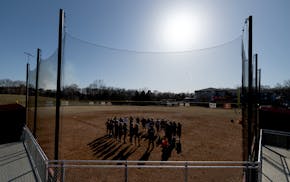BLOOMING PRAIRIE, Minn. – People often gasp when Nancy Vaillancourt brings out the Ku Klux Klan hood.
The dirty, yellowing head covering once belonged to Mary Edmunds, a woman who lived west of Rochester in the 1920s when the KKK was most active in Minnesota. It's one of two that Edmunds' family donated to Vaillancourt, not knowing what else to do with them.
It's also proof of a dark period in Minnesota history when prejudice reigned as the KKK renewed its influence across the U.S. shortly after World War I. The KKK began as a violent white supremacist group in the South after the Civil War and later morphed into using white-hooded robes and cross burnings to wield its terror. In the 1920s, KKK members held rallies, marched in parades, had their own newspapers and preached an "America first" mindset to anyone who would listen.
A longtime Steele County librarian, Vaillancourt has researched the KKK's presence in Minnesota for almost two decades. Her research has led her to give talks around the state and write academic articles with historian and author Elizabeth Dorsey Hatle.
Vaillancourt retired at the end of August, which gives her more time to pursue her passion: investigating how prevalent the KKK was in Minnesota when the organization was at its peak.
"People don't want to believe that it happened here, that we were all such better people than those in the South who were prejudiced," Vaillancourt said. "I want people to know the truth. I want them to know it did happen."
Vaillancourt always had an interest in history, but she never thought much about the KKK until a patron in 2005 asked about why there had been KKK members in Owatonna.
Her boss didn't think she'd find much, Vaillancourt said, telling her it was a secret organization.
But the KKK was anything but secret in the 1920s. Newspapers at the time reported on KKK activities as early as 1921 in Duluth, a year after three Black circus workers were lynched after they were falsely accused of raping a white woman.
The KKK spread to many corners of the state, from Minneapolis to Virginia, where school board members all claimed they were KKK members and urged that the Bible be taught in public schools.
Southeast Minnesota was no exception; Albert Lea hosted the first major statewide rally in 1923. The KKK organized a member initiation ceremony in nearby Austin in September of that year, welcoming 400 into its ranks while leaders vowed to open chapters in every county in Minnesota.
There were marches in Rochester and state conventions in Faribault. Owatonna held three state gatherings between 1924-26, including on land that KKK members purchased and dubbed "Klan Park." Leaders would exaggerate their numbers, claiming at one point that Minnesota had more than 10,000 KKK members.
Local newspaper accounts Vaillancourt dug up reveal hints of KKK activity. There are reports of KKK speeches at small Protestant churches, where pastors welcomed hooded members and sang their praises. At the same time, articles from Rochester describe panic among residents who thought they spotted hooded figures prowling around at night.
The KKK members at the time denounced what they called outside influence from foreigners, Catholics, Jews and anyone who didn't agree with nationalist Christian teachings. They'd leave messages on doorways or in newspapers advertising secret meetings, and they often spoke about educating children in what they considered the right way and protecting the purity of women.
"Studying the Klan for so long and noticing the parallels over the past 20 years, I'm kind of in shock that it happened," Vaillancourt said. "At the time that I started, I was like, 'Oh, we're so much better now,' and now I feel like we could be on the same downward trend of prejudice towards others."
People at Vaillancourt's first presentations were shocked to learn that the KKK had been active in Minnesota, even if only for a while. The KKK largely lost steam by the end of the 1920s after a national leader in Indiana was convicted of raping and murdering a woman, damaging the organization's public reputation.
"We can't just hide the bad history in textbooks or closets somewhere." said Jennifer Thiel, executive director of the Steele County Historical Society. "There are times where we have to present it ... so that we prevent those atrocities from happening again in the future."
Thiel said Vaillancourt's work was "a wonderful asset" to help preserve local history, as well as an invitation to others to share their own stories about how relatives were involved or heard about the KKK.
Vaillancourt remembers her grandfather telling her stories about KKK members who intimidated German-born residents near Winona from speaking German in public in the early 1920s.
One neighbor, her grandfather told her, ignored that advice at first. He woke up one morning to find his barn covered in yellow paint — essentially calling him a coward and a traitor to the U.S.
Her research has also found her a unique niche as a contact point for people willing to hand over KKK items from their parents, aunts or uncles who used to be involved in the group. She's received everything from buttons and coins, letters and certificates to the aforementioned hood and a large-scale banner from a Women of the Ku Klux Klan group in Steele County.
"A lot of them were anxious about getting rid of things, but they hadn't felt right about destroying them because it tells a story," Vaillancourt said.
Vaillancourt is enjoying her retirement for the next month or so, but she plans to start traveling later this fall to see whether the KKK's claim in Austin all the way back in 1923 came true: Did the KKK really have charters in every Minnesota county?
If so, she says, it's another reason why people should know more about KKK history in Minnesota.
"We can put our heads in the sand and pretend it didn't happen," she said, "but it did."

Golden Valley highway crash leaves one man dead; suspect in custody
Semi kills 10 cows on southeastern Minnesota highway
In South Carolina, Walz says Democrats 'need to change the attitude'
Two injured in shooting outside University of Minnesota arena after high school graduation

